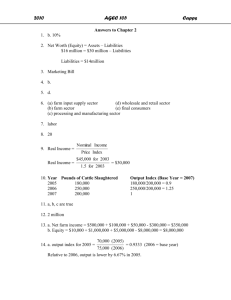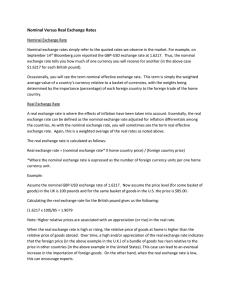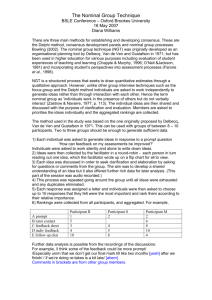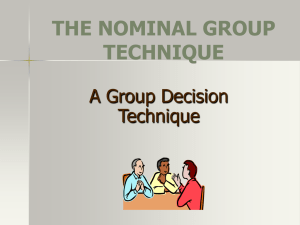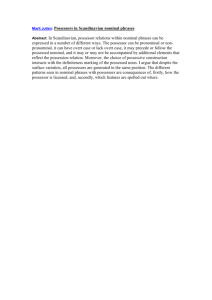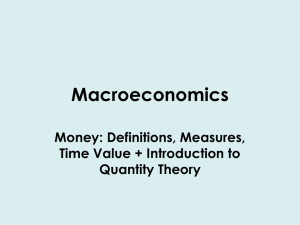BM-04 Word Document
advertisement
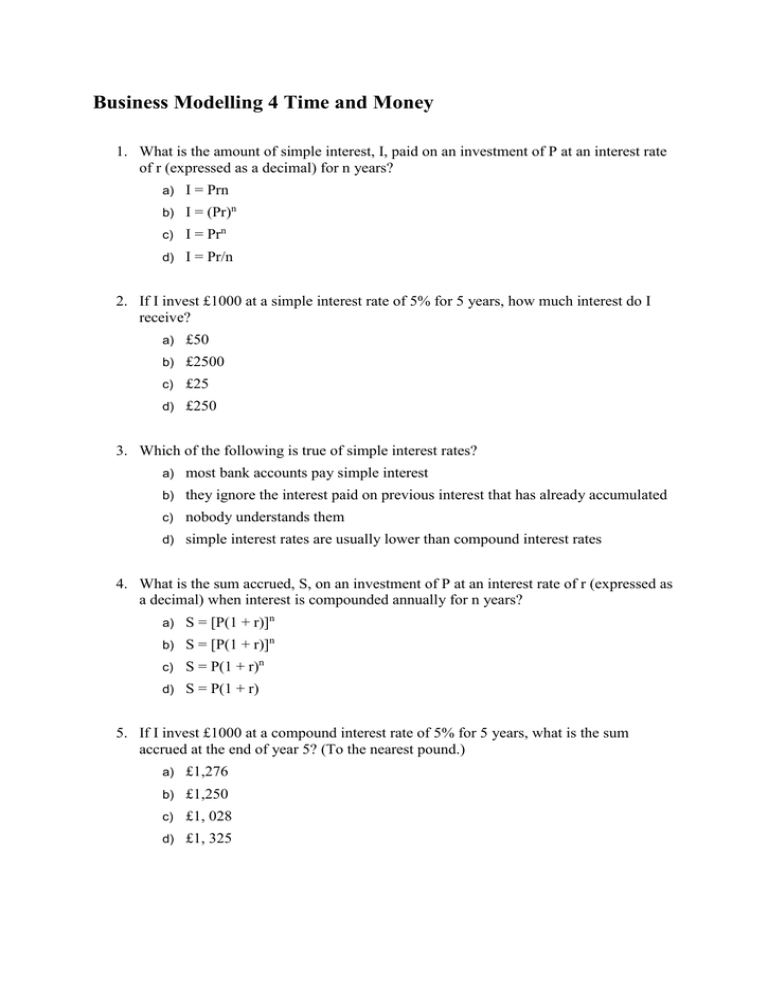
Business Modelling 4 Time and Money 1. What is the amount of simple interest, I, paid on an investment of P at an interest rate of r (expressed as a decimal) for n years? a) I = Prn b) I = (Pr)n c) I = Prn d) I = Pr/n 2. If I invest £1000 at a simple interest rate of 5% for 5 years, how much interest do I receive? a) £50 b) £2500 c) £25 d) £250 3. Which of the following is true of simple interest rates? a) most bank accounts pay simple interest b) they ignore the interest paid on previous interest that has already accumulated c) nobody understands them d) simple interest rates are usually lower than compound interest rates 4. What is the sum accrued, S, on an investment of P at an interest rate of r (expressed as a decimal) when interest is compounded annually for n years? a) S = [P(1 + r)]n b) S = [P(1 + r)]n c) S = P(1 + r)n d) S = P(1 + r) 5. If I invest £1000 at a compound interest rate of 5% for 5 years, what is the sum accrued at the end of year 5? (To the nearest pound.) a) £1,276 b) £1,250 c) £1, 028 d) £1, 325 6. If a bank quotes a nominal interest rate of 5% a year payable daily, what does this mean? a) the bank pays 5% at the end of the year b) the bank pays 5% interest a day c) the bank pays (5/365)% every day d) the bank pays an amount of interest daily that accumulates to 5% at the end of the year 7. Interest on a savings account is payable monthly. The nominal rate is 5%. What is the effective rate of interest? a) 4.9% b) 5.12% c) 4.68% d) 5.55% 8. The effective interest is…. a) slightly lower than the nominal interest b) the same as the nominal interest c) slightly higher than the nominal interest d) either lower or higher than the nominal interest 9. A sum of £250 is invested at a nominal rate of 8% over 6 years. How much will accrue with annual interest payments? a) £402.11 b) £396.72 c) £398.46 d) £321.69 10. How much will accumulate in the account described in question 9 if the interest is compounded quarterly? a) £402.11 b) £396.72 c) £398.46 d) £321.69 11. What is the main reason for the value of money to decline over time? a) interest payable b) bank and other charges c) uncertain economic conditions and exchange rates d) inflation and opportunity costs 12. Find the present value of £50,000 in 10 years’ time if the discount rate of 8% is calculated annually. a) £46,296 b) £41,017 c) £22,645 d) £23,160 13. Find the value of £50,000 in 10 years’ time if the discount rate of 8% is calculated quarterly? a) £46,296 b) £41,017 c) £22,645 d) £23,160 14. What is the net present value of an investment? a) the future value of benefits minus their discounted values b) the total discounted benefits minus the discounted costs c) the discounted benefits plus the future value of costs d) the discounted value of costs 15. What is the internal rate of return? a) the effective interest rate for an investment b) the discounting rate that gives a net present value of zero c) the opportunity cost of an investment d) the average annual return over the life of an investment 16. A property developer buys a property for £40,000 now. She intends to spend £20,000 at the end of year 1, on work but hopes to sell at the end of year 2 for £70,000. The internal rate of return on this projects is a) less than 5% b) between 5 and 7% c) between 7 and 10% d) more than 10% 17. What are the first four terms of a geometric series with initial value a and ratio R? a) a, a, a, a b) a, aR, aR2, aR3 c) a, a(1+R), a(1+R)2, a(1+R)3 d) a, a+R, a+2R, a+3R 18. What is the sum of all the terms in a geometric series? a) a / (1-R) b) a (Rn -1) c) a (1-R) / (Rn – 1) d) na 19. If you put €100 at the end of every month into a bank account with a nominal interest rate of 12% paid monthly, what equation describes the amount accrued at the end of 2 years? a) 100 × 1.0124 b) 100 × (1.0124 -1) c) 100 × (1.0124 -1) / (1.01 – 1) d) 100 × 1 / (1.01 -1)24 20. If you put €100 at the end of every month into a bank account with a nominal interest rate of 12% paid monthly for two years, how much will have accrued over the two years, and how much of this will be interest? a) €2697, €497 b) €2697, €297 c) €3047, €647 d) €4688, €2488 21. How much can I borrow to buy a house on a 25-year mortgage if I don’t want my end-of-month payments at a nominal rate of interest of 9% per annum to exceed £300? a) £30,263 b) £35,748 c) £45,065 d) £26,812 22. I borrow £5,000 which must be repaid by 24 monthly instalments starting at the end of this month at a rate of interest of 1.2% a month. How much must each instalment be? a) £241 b) £186 c) £278 d) £295 Question Answer 1 A 2 D 3 B 4 C 5 A 6 C 7 B 8 C 9 B 10 A 11 D 12 D 13 C 14 B 15 B 16 C 17 B 18 A 19 C 20 B 21 B 22 A
